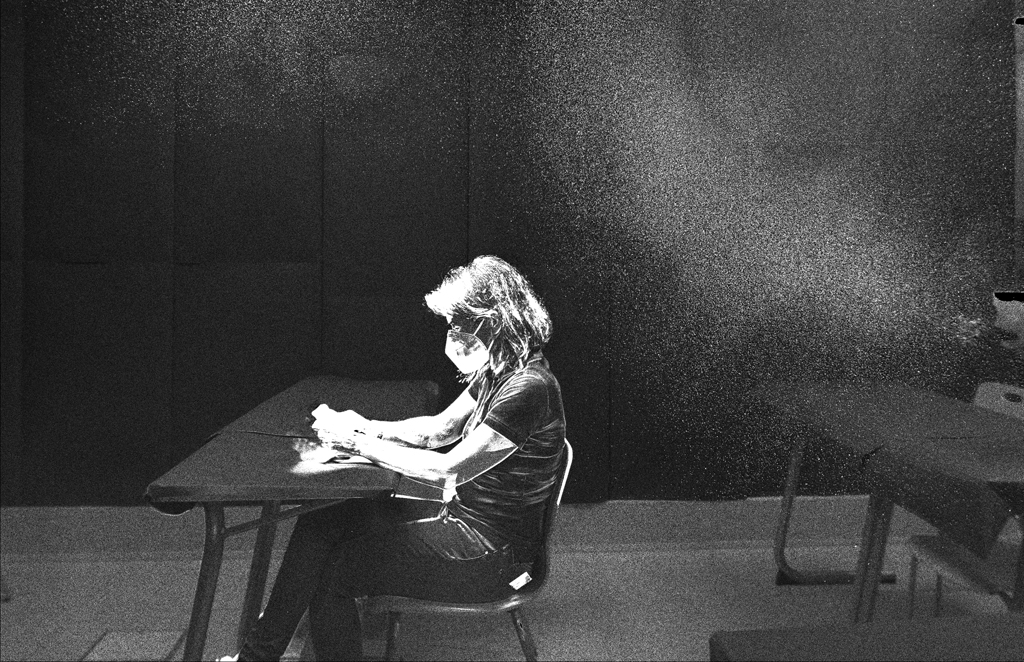Scientists, also from the TU Delft, call on the WHO to pay more attention to the indoor spread of the coronavirus. Especially in view of the coming autumn and winter.
Experiment on the transport of aerosoles in the TU Delft Senselab (Photo: Dadi Zhang, technology: Fulvio Scarano)
Professor of Indoor Climate Philomena Bluyssen, with a contribution from the TU Delft Covid-19 Response Fund, is conducting research into the spread of aerosols in indoor spaces. She is one of the 239 researchers who signed the open letter to the World Health Organization WHO. In it they call on the WHO to pay more attention to ‘the third infection route’ of the coronavirus.
‘Since our first letter at the beginning of April, there has been new evidence pointing to the spread of Covid-19 via small suspended moisture particles (aerosols),’ scientists write. At the same time, the other two infection routes, saliva droplets and touch, seem to be greatly reduced by keeping a distance and washing hands.
Video registration of the aerosoles experiment in het Senselab
What is the motivation for the letter?
“Despite the evidence we now see of airborne transmission, that route of infection is still not recognized by the WHO.”
The Dutch national institute for public health RIVM, which follows the WHO, recommends the Dutch Building Decree as a guideline for ventilation. What’s wrong with that?
“The Buildings Decree was not developed for the prevention of transmissions of infectious diseases. It is only intended to provide for minimum ventilation. And that’s not enough to maintain public health.”
You have done research on the circulation of aerosols together with Prof. Dr. Fulvio Scarano (Aerospace Engineering). Is your position based on that?
“Among other things. We can show that when you exhale, the aerosols travel over 1.5 meters. If there’s not enough ventilation, the concentration of aerosols builds up. They can float in the air for a very long time. We’ve shown that.”
You recommend more supply of outside air, and less recirculation. Have you quantified that?
“No, we haven’t. We want to focus on the use of natural ventilation in the absence of ventilation systems. We’ve indicated there that research should be done into its effectiveness. Is it enough to open a window for ten minutes, or do you have to keep the window open all the time if you have guests? We also focus on various forms of mechanical ventilation, such as mixing and displacement ventilation. We have set up a study for this purpose in order to be able to specify what we need to do.”
What does this mean for TU Delft lecture halls?
“There was always a lot of air reused there. Warm air was recirculated to save energy. Increased energy consumption will also become an issue because what we recommend is: one hundred percent fresh outside air and no recirculation. Because we don’t know how much of that virus can come back through the installations. That also needs to be researched.”
So if you act as a precaution, it’s 100% fresh air intake, and with heat exchangers to regain the heat.
“Exactly. What we also need to investigate is the direction of the airflow. You blow air in somewhere and you suck it off with mechanical ventilation. If you’re just in the stream of contaminated air, you get everything along. You have to take that into account, too.”
You have received 10,000 euros from the TU Delft Covid Response Fund for research, but that is not nearly enough.
“No, that’s not enough at all. We did apply for funding from ZonMW, which may help. But in order to do really good research, a lot more money is needed, and also more people.”
- The open letter refers to the publication It is Time to Adress Airborne Transmission of COVID-19 by Lidia Morawska (International Laboratory for Air Quality amnd Health, Queensland University of Technology) and Donald K. Milton (Institute for Applied Environmental Health, University of Maryland School of Public Health).
- The behaviour of aerosols has been made visible by a technique developed by Prof. Dr. Fulvio Scarano. A direct image of aerosols with a size of a micrometer is impossible. Instead, Scarano uses highly visible bubbles that are 500 times larger but, like aerosols, float in the air.
- Update: The RIVM just published a publication recognising the possibility of contamination via aerosols. “As long as it is uncertain which part of the aerosols from breathing, speaking, coughing and sneezing is contagious, and as long as it is not known what dose leads to contamination, we recommend taking precautions,” the RIVM researchers write. “I’m glad it’s being investigated”, replies Philo Bluyssen by email to the publication.
Do you have a question or comment about this article?
j.w.wassink@tudelft.nl


Comments are closed.